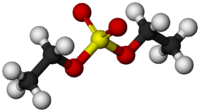Diethyl sulfate
Diethyl sulfate is a highly toxic and likely carcinogenic chemical compound with formula (C2H5)2SO4. It occurs as a colorless, oily liquid with a faint peppermint odor and is corrosive.
 | |
 | |
| Names | |
|---|---|
| Other names
Sulfuric acid diethyl ester | |
| Identifiers | |
3D model (JSmol) |
|
| ChEMBL | |
| ChemSpider | |
| ECHA InfoCard | 100.000.536 |
| KEGG | |
PubChem CID |
|
| RTECS number |
|
| UNII | |
CompTox Dashboard (EPA) |
|
| |
| |
| Properties | |
| C4H10O4S | |
| Molar mass | 154.18 g·mol−1 |
| Appearance | Colorless liquid |
| Density | 1.2 g/mL |
| Melting point | −25 °C (−13 °F; 248 K) |
| Boiling point | 209 °C (408 °F; 482 K) (decomposes) |
| decomposes in water | |
| Vapor pressure | 0.29 mm Hg |
| -86.8·10−6 cm3/mol | |
| Hazards | |
EU classification (DSD) (outdated) |
Toxic (T) Carc. Cat. 2 Muta. Cat. 2 |
| R-phrases (outdated) | R45 R46 R20/21/22 R34 |
| S-phrases (outdated) | S53 S45 |
| NFPA 704 (fire diamond) | |
| Flash point | 104 °C (219 °F; 377 K) |
| Related compounds | |
Related compounds |
Dimethyl sulfate; diethyl sulfite |
Except where otherwise noted, data are given for materials in their standard state (at 25 °C [77 °F], 100 kPa). | |
| Infobox references | |
Diethyl sulfate is used as an alkylating agent to prepare ethyl derivatives of phenols, amines, and thiols. It is used to manufacture dyes and textiles.[1]
Property
Diethyl sulfate is moisture sensitive liquid. Heating can lead to release of irritating gases and vapors.[2]
Toxicity
Diethyl sulfate is a strong alkylating agent which ethylates DNA and thus is genotoxic. According to the International Agency for Research on Cancer (IARC), as of 1999 there is not sufficient evidence for the carcinogenic properties of diethyl sulfate in humans, but there is in animals. It is classified as a Group 2A (probably carcinogenic to humans) carcinogen by the IARC.[3]
Preparation
It can be prepared by absorbing ethylene into concentrated sulfuric acid or by fuming sulfuric acid into diethyl ether or ethanol.[4]
References
- "Diethyl sulfate". pubchem.ncbi.nlm.nih.gov. Pubchem. Retrieved 2016-03-06.
- "SAFETY DATA SHEET--Diethyl sulfate". ThermoFisher Scientific. Aug 21, 2018. Retrieved June 18, 2020.
- IARC (1999). "Diethyl Sulfate". Summaries and Evaluations. 71. International Agency for Research on Cancer (IARC): 1405. Cite journal requires
|journal=(help) - Dow (June 24, 2006). "Diethyl Sulfate" (PDF). Product Safety Assessment. Dow Chemical Company. Retrieved 2016-03-05. Cite journal requires
|journal=(help)
Further reading
- Buck, J. R.; Park, M.; Wang, Z.; Prudhomme, D. R.; Rizzo, C. J. (2000). "9-Ethyl-3,6-Dimethylcarbazole (DMECZ)". Organic Syntheses. 77: 153.; Collective Volume, 10, p. 396
- Theodore, S.; Sai, P. S. T. (2001). "Esterification of Ethanol with Sulfuric Acid: A Kinetic Study". Canadian Journal of Chemical Engineering. 79 (1): 54–64. doi:10.1002/cjce.5450790109.
External links
- "Diethyl sulfate". Webbook. NIST.
- "DIETHYL SULFATE -- ICSC: 0570". Inchem.
- "Diethyl sulfate" (PDF). IARC Monographs. 71. IARC. 1992. Cite journal requires
|journal=(help)
